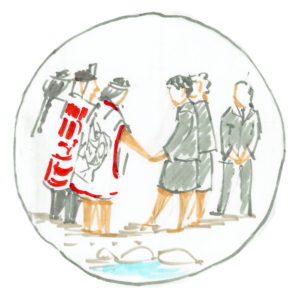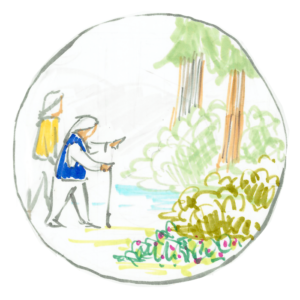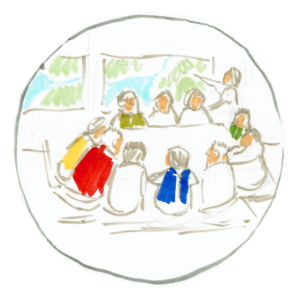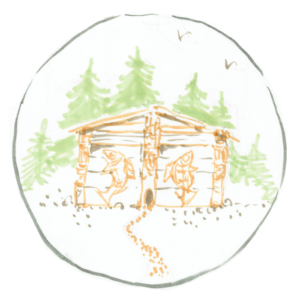Steps
Step 1: Reconciliation Agreements
 Reconciliation agreements are made between a First Nation(s) and the provincial and/or federal governments. These agreements outline an intention to work together on decisions around land use guided by principles of the UN Declaration of Rights of Indigenous People, the Truth and Reconciliation Commission’s Calls to Action and other pivotal sources of guidance.
Reconciliation agreements are made between a First Nation(s) and the provincial and/or federal governments. These agreements outline an intention to work together on decisions around land use guided by principles of the UN Declaration of Rights of Indigenous People, the Truth and Reconciliation Commission’s Calls to Action and other pivotal sources of guidance.
These agreements provide a means to work towards social and economic equity without the nations formally having to go through the lengthy and costly process of the courts to determine exactly those lands to which they have rights and responsibilities. First Nations can work collaboratively with governments to make decisions about these land without extinguishing their assertion of rights and title, as was the case with the old treaties.
Many of the First Nations who opted out of treaty negotiations have gone this route.
In 2014, following the Tsilhqot’in decision, a commitment was made between the BC government and First Nations Leadership Council to make all relationships between them “grounded in the recognition of Aboriginal Title and Rights.”
Since that time, old agreements have been renegotiated and new agreements negotiated based on this commitment. Examples of new agreements include the Coastal First Nations MoU, Coastal First Nations amending agreement, Carrier Sekani Pathway Forward 2.0 Agreement Amending Agreement #2 , and Secwepemc Government to Government Letter of Commitment [Qwelminte] on Reconciliation.
These agreements provide the opportunity for Nations to create their own unique land stewardship plan that are typically very different from business-as-usual scenarios.
Step 2: Atmosphere Benefit Agreements
 Atmospheric Benefit Agreements (ABAs), also known as Indigenous Atmospheric Benefit Agreements, enable First Nations to earn revenues from retaining and improving carbon storage in forests. The agreements clarify ownership of rights to sell carbon. This is an essential prerequisite for any carbon project so an important step for providing a new revenue source. These agreements typically have only been entered into where the First Nation has signed a Reconciliation Protocol or similar agreement with the provincial government.
Atmospheric Benefit Agreements (ABAs), also known as Indigenous Atmospheric Benefit Agreements, enable First Nations to earn revenues from retaining and improving carbon storage in forests. The agreements clarify ownership of rights to sell carbon. This is an essential prerequisite for any carbon project so an important step for providing a new revenue source. These agreements typically have only been entered into where the First Nation has signed a Reconciliation Protocol or similar agreement with the provincial government.
Atmospheric Benefit Agreements replace existing stumpage agreements through allocation of the benefits from the carbon project profit. In many cases, First Nations retain 80 – 90 per cent of revenues earned, while the province might retain 10-20%.
First Nations can determine not only the other values associated with their carbon projects, (such as biodiversity, cultural and social equity), but they can also choose who buys the carbon credits they sell. First Nations have exercised these rights and have refused buyers who didn’t meet the standards the Nations follows.
Local and provincial governments have also supported these projects through purchasing agreements. Cities, that are large emitters, have made carbon neutral commitments and can offset their impacts by purchasing credits directly from nations, e.g., Cheakamus Community Forest. In other words, local and provincial governments pay rural First Nations to steward the forest and thereby offset their impacts.
At least 14 Nations have signed Atmospheric Benefit Agreements (e.g., Coastal First Nations Atmospheric Benefit Agreement, Nanwakolas First Nations Atmospheric Benefit Sharing Agreement). See also Atmospheric benefit agreements Feb 24 2022.docx
For more information, see Carbon Projects in the Streams section.
Step 3: Land Stewardship Plans
 First Nations have become international leaders for the values they seek to represent in their land stewardship plans. These plans can integrate biodiversity, cultural values, water, climate and human health.
First Nations have become international leaders for the values they seek to represent in their land stewardship plans. These plans can integrate biodiversity, cultural values, water, climate and human health.
These plans are the first essential steps to negotiations. They are typically based on principles of ecosystem-based management that provide for the maintenance and/or restoration of culturally significant sites, resource gathering areas, wildlife habitat, old growth forest protection, culturally and ecologically sustainable allowable annual cut (AACs), and other values.
Land stewardship plans are found within Indigenous Protected and Conserved Areas (IPCAs). The plans address the pre-requisites of carbon project plans since they are different from BC’s business-as-usual logging plans where virtually no legislated protection exists beyond timber values.
Land stewardship planning usually follows extensive community consultation and is often done by a Nations’ own planners.
Examples of land stewardship plans include plans developed by the Coastal First Nations, Cheakamus Community Forest (Sḵwx̱wú7mesh Úxwumixw (Squamish Nation) and the Lil̓wat7úl (Líl̓wat Nation).
Step 4: Governance
 Many Nations are exploring how to move away from the current elected governance system under the Indian Act for Reserves and practice traditional governance systems over their larger territories within adapted legal structures like trusts, First Nations societies and non-profits and community forests. Many First Nations are reestablishing their Indigenous laws and governance systems. (See UVic Indigenous Legal Orders, Ashnola Protected and Conserved Area). The goal for these new models is to recognize the validity of Indigenous laws and encourage greater participation in socio-economic activities, such as operating businesses and receiving grants, while applying Indigenous laws and hereditary leadership principles.
Many Nations are exploring how to move away from the current elected governance system under the Indian Act for Reserves and practice traditional governance systems over their larger territories within adapted legal structures like trusts, First Nations societies and non-profits and community forests. Many First Nations are reestablishing their Indigenous laws and governance systems. (See UVic Indigenous Legal Orders, Ashnola Protected and Conserved Area). The goal for these new models is to recognize the validity of Indigenous laws and encourage greater participation in socio-economic activities, such as operating businesses and receiving grants, while applying Indigenous laws and hereditary leadership principles.
New models may include:
- stewardship societies and organizations
- guardian associations
- co-managed community forest societies
- land trusts with indigenous-adapted covenants
- Indigenous protected and conserved areas
- alliances of hereditary and elected leadership
- First Nations B-Corporations
First Nations have set up alternative non-profit governance models to implement stewardship plans and attract a diversity of revenue sources. These governance models (“societies”) can receive funding from donors and government for vital services like fire prevention, watershed monitoring, search and rescue, health and wellness programs, monitoring, impact assessments and more. Examples include the Secwepemcul’ecw Restoration and Stewardship Society, North Coast Skeena First Nations Stewardship Society, Cheakamus Community Forests Society, WSANEC Leadership Council, and Enowkwin Centre.
Communities can name beneficiaries or trustees such as future generations to stewardship organizations. This embeds the Indigenous principle of considering the seven generations to come. Nations that have done this include the Qqs Society in the Heiltsuk First Nation. Governance models that name future generations as a beneficiary can empower a community, even communities with overlapping territories that were created by the Indian Act. This allows time to restore traditional governance within a transitional structure to prevent seizure through debt, voter suppression, certificates of possession, shareholder takeover and other “divide and conquer” tools.
Step 5: Implement Stewardship Plan
 Implementing a land stewardship plan requires internal organization and financial support to start. Any one of the revenue streams can be used to kick start a stewardship plan but a forest carbon project is an established financial stream that pays for the annual costs of looking after land. It is hard to find donations or grants for stewardship of land. A project needs a secure legal arrangement to provide what is called “permanence” to provide assurance to buyers and validators that the carbon stocks (the forests in the agreement) will remain intact for up to 100 years in the future. The formation of non-profit societies with the support of elected and hereditary governance that have third-party oversight provides the highest level of permanence and protection for carbon projects, and therefore, the highest return to communities.
Implementing a land stewardship plan requires internal organization and financial support to start. Any one of the revenue streams can be used to kick start a stewardship plan but a forest carbon project is an established financial stream that pays for the annual costs of looking after land. It is hard to find donations or grants for stewardship of land. A project needs a secure legal arrangement to provide what is called “permanence” to provide assurance to buyers and validators that the carbon stocks (the forests in the agreement) will remain intact for up to 100 years in the future. The formation of non-profit societies with the support of elected and hereditary governance that have third-party oversight provides the highest level of permanence and protection for carbon projects, and therefore, the highest return to communities.
